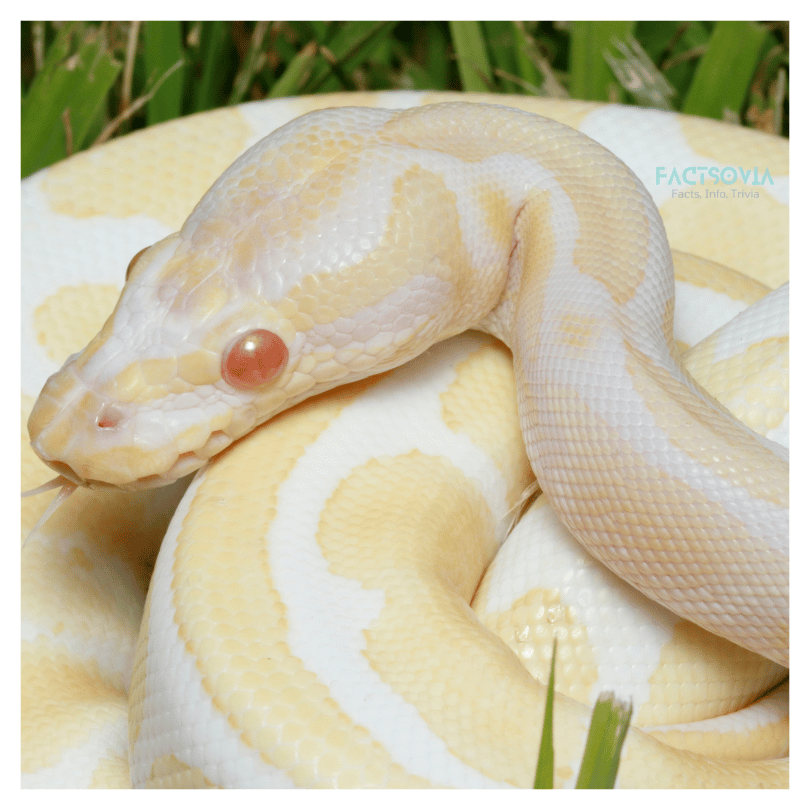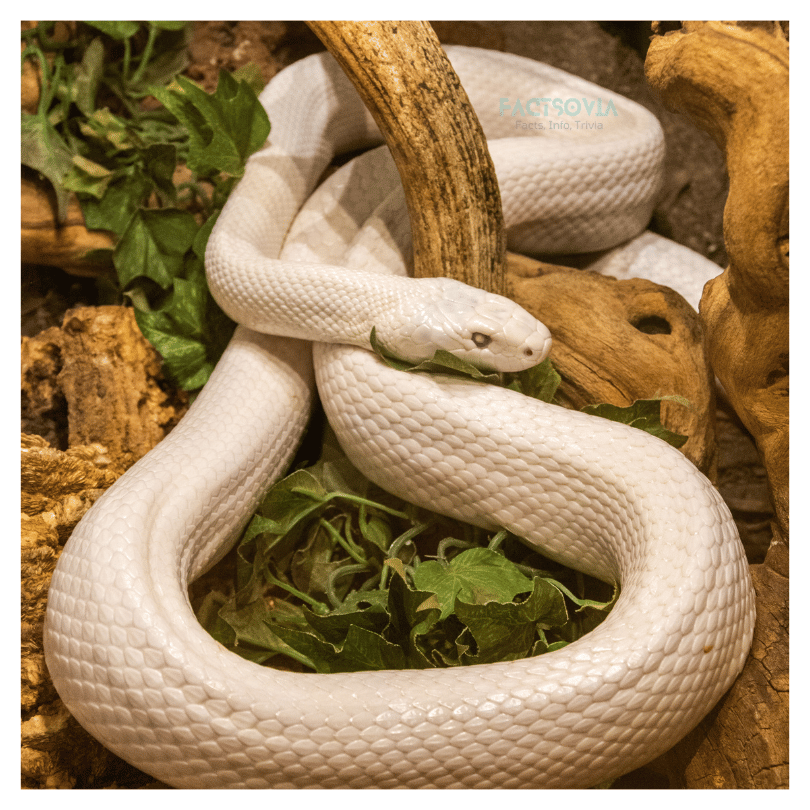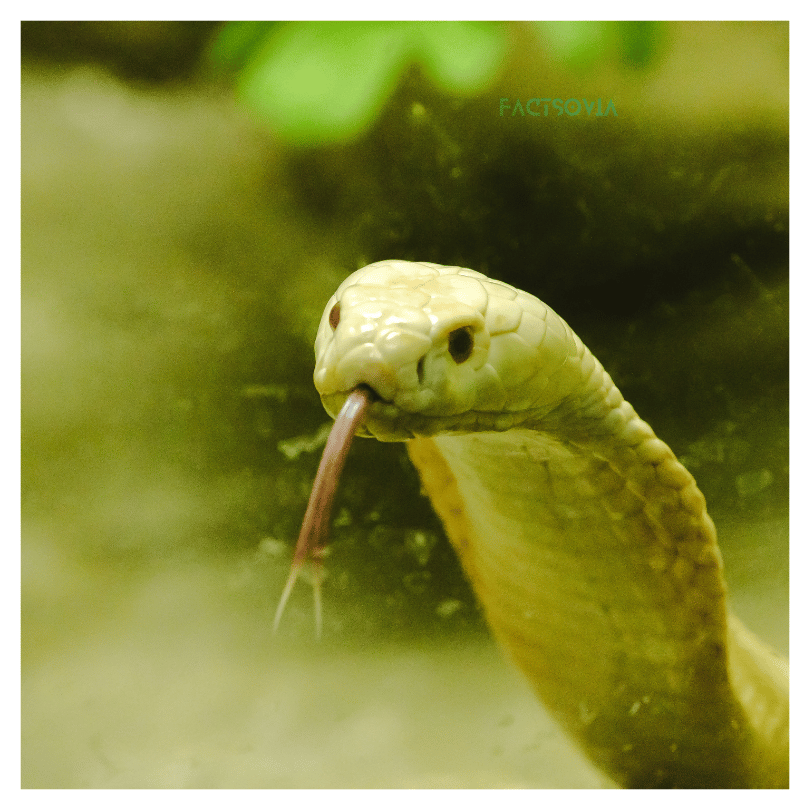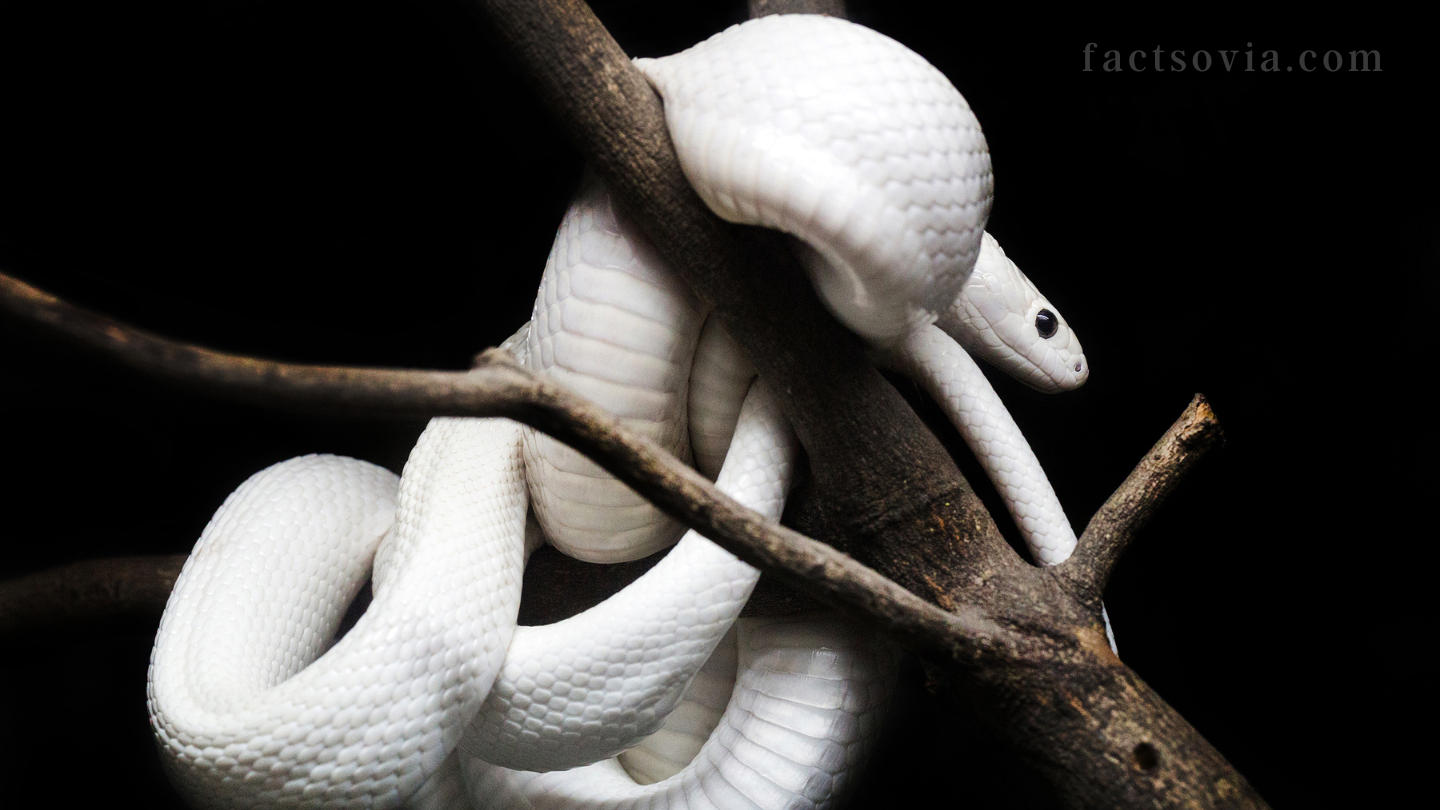We use affiliate links to run our site. When you buy through links on our site, we may earn an affiliate commission, without any added cost to you. Learn more
If you are looking for a unique and stunning pet snake, you might want to consider getting a white snake. White snakes are not only beautiful, but also rare and fascinating.
They come in different types and sizes, from the tiny albino hognose to the massive super phantom reticulated python. But what makes a snake white? And what are the best white snakes to keep as pets?
In this article, we will answer these questions and more. We will also give you some tips on how to care for your white snake and where to find them.
I am sure you will like the journey.
What are white snakes?
White snakes are a group of reptiles that have a pale or albino coloration. They can belong to different species and families, such as cobras, pythons, rattlesnakes, and vipers.
Some white snakes are rare and considered sacred in some cultures, while others are more common and may be kept as pets or used for snake shows.
White snakes have the same characteristics and behaviors as their normal-colored counterparts, but they may have some disadvantages in terms of camouflage and health issues.
What Makes Them White
White snakes are the result of genetic mutations that affect their coloration. There are two main types of mutations that can cause a snake to be white: albinism and leucism.
Albinism is the absence of melanin, a pigment that gives color to the skin, eyes, and hair. Albinism makes a snake white with yellow or orange markings, and red or pink eyes.
Leucism is the partial or complete loss of all types of pigments, including melanin and carotenoids. Leucism makes a snake completely white or white with some spots or patches of color and normal eye color.
Why White Snakes Are Rare?
White snakes are not commonly found in the wild, as their striking coloration tends to make them stand out rather than blend into their natural surroundings.
Snakes, being predatory creatures, rely on their ability to camouflage themselves or sneak up on prey. So, a bright white snake can face challenges in successfully hunting and may become vulnerable to other predators.
However, thanks to the efforts of dedicated breeders, the availability of white snakes as pets has significantly increased over the years.
Can you have a white snake as a pet?
Yes, you can have a white snake as a pet. There are several snake species that exhibit white coloration, such as white ball pythons, white corn snakes, and white kingsnakes.
These snakes can be kept as pets by reptile enthusiasts who have the proper knowledge and resources to care for them.
Are White Snakes Poisonous?
The term “White Snake” typically refers to the coloration of a snake and does not indicate its venomous or non-venomous nature. Snakes with white coloration, such as albino or leucistic snakes, can be both venomous and non-venomous, depending on the species.
It’s important to research the specific species of snake to determine if it is venomous and understand its potential dangers.
Florida Kingsnake: Interesting Facts and Trivia
Are albino snakes good pets?
Albino snakes can make good pets for reptile enthusiasts. However, it’s essential to consider the specific needs and requirements of the particular species of albino snake.
Albino snakes, like other snakes, require proper housing, temperature, and humidity control, a suitable diet, and regular veterinary care.
Additionally, some albino snakes may have specific genetic or health considerations that need attention. It’s crucial to research and understand the specific care requirements of the albino snake species you are interested in before considering it as a pet.
Top 10 White Snakes As Pets
| Name of the Snake | Scientific Name | Unique Characteristics |
|---|---|---|
| Albino Ball Python | Python regius | Albino ball pythons are white with yellow markings and red eyes. They are popular pets because of their docile nature and unique appearance. |
| White Kingsnake | Lampropeltis californiae | White kingsnakes are non-venomous and have a unique defense mechanism where they release a foul-smelling musk when threatened. |
| Leucistic Texas Rat Snake | Elaphe obsoleta lindheimeri | Leucistic Texas rat snakes are white with blue eyes and are often mistaken for albino snakes. They are native to Texas and are known for their climbing ability. |
| White-lipped Python | Bothrochilus albertisii | White-lipped pythons are native to New Guinea and are known for their striking white lips. They are venomous and can grow up to 8 feet long. |
| Creamsicle Corn Snake | Pantherophis guttatus | Creamsicle corn snakes are a popular pet snake because of their bright orange and white coloration. They are non-venomous and can grow up to 6 feet long. |
| White Oak Snake | Rhadinaea flavilata | White oak snakes are small, non-venomous snakes that are native to the southeastern United States. They are named after their preferred habitat of oak forests. |
| White-sided Black Rat Snake | Pantherophis obsoletus | White-sided black rat snakes are non-venomous and are found in the eastern United States. They have a black body with white stripes on their sides. |
| White Speckled Rattlesnake | Crotalus mitchellii | White speckled rattlesnakes are venomous and are found in the southwestern United States and Mexico. They have a unique white speckled pattern on their scales. |
| White Cobra | Naja naja | White cobras are venomous and are found in Southeast Asia. They have a unique white coloration and are highly venomous. |
| White Phase Eastern Diamondback Rattlesnake | Crotalus adamanteus | White phase eastern diamondback rattlesnakes are venomous and are found in the southeastern United States. They have a unique white coloration and can grow up to 8 feet long. |
1. Albino Ball Python

The Albino Ball Python is a popular choice among snake enthusiasts due to its stunning white and yellow coloration. These docile snakes are known for their gentle temperament, making them suitable for both beginner and experienced snake owners. With proper care and handling, Albino Ball Pythons can become affectionate and interactive pets.
2. White Kingsnake
White Kingsnakes, also known as Leticia’s Coral Snakes, are beautiful non-venomous snakes that sport a striking combination of white and black or white and yellow patterns.
They are relatively easy to care for and have a calm disposition, making them an excellent choice for snake enthusiasts of all levels. These snakes are known for their inquisitive nature and can provide hours of entertainment.
3. Leucistic Texas Rat Snake

The Leucistic Texas Rat Snake is a captivating snake with its pale white scales and contrasting dark eyes. It is an active and fast-moving species that requires spacious enclosures to thrive.
This snake can be a bit more challenging to handle due to its quickness, but with patience and proper training, it can become an impressive pet for experienced snake owners.
4. White-lipped Python
Known for its stunning ivory-colored scales and distinctive white lips, the White-lipped Python is a visually striking snake that demands attention.
While they require more advanced care and experience, these pythons can form strong bonds with their owners and become fascinating pets for those willing to invest time and effort into their care.
5. Creamsicle Corn Snake
The Creamsicle Corn Snake is a popular morph of the Corn Snake species, featuring a white and orange pattern that resembles an icy creamsicle treat. These snakes have a friendly disposition and are relatively easy to handle, making them an excellent choice for beginner snake owners. Their beautiful coloration adds a touch of vibrancy to any snake collection.
6. White Oak Snake
The White Oak Snake, also known as the Northern Pine Snake, is a fascinating white-colored snake with black markings. This species requires spacious enclosures and a diet consisting mainly of rodents.
While they may be more challenging to find as captive-bred specimens, White Oak Snakes can make rewarding pets for experienced snake enthusiasts looking for a unique addition to their collection.
7. White-sided Black Rat Snake
With its striking black-and-white coloration, the White-sided Black Rat Snake is an eye-catching reptile that stands out among its counterparts. While it may exhibit some feistiness, this snake can become tamed and make a captivating pet for experienced owners.
Providing a proper environment and handling it with care is crucial for developing a good relationship with this species.
8. White Speckled Rattlesnake
For those seeking a more adventurous and challenging pet, the White Speckled Rattlesnake might be the perfect choice. With its pale scales and unique speckled pattern, this venomous snake requires expert care, handling, and licensing.
Only experienced snake enthusiasts with a deep understanding of venomous reptile husbandry should consider keeping this species.
9. White Cobra

The White Cobra is an incredibly rare and exotic snake that mesmerizes with its snowy appearance. However, it’s important to note that cobras are highly venomous, and keeping them as pets is not recommended or legal in most regions.
The White Cobra is included on this list to highlight its captivating beauty but should only be appreciated from a safe distance in professional and regulated settings.
10. White Phase Eastern Diamondback Rattlesnake
The White Phase Eastern Diamondback Rattlesnake is a visually striking serpent characterized by its pale scales and diamond-shaped markings. This species is highly venomous and requires expert handling and specialized care.
Due to their potentially dangerous nature, it is vital to emphasize that keeping venomous snakes like the White Phase Eastern Diamondback Rattlesnake should be left to professional herpetologists or institutions equipped to handle them safely.
Caring for White Snakes
While the allure of white snakes may be undeniable, it’s essential to understand the specific care requirements associated with keeping these unique reptiles.
Here are some key considerations when it comes to caring for white snakes:
Habitat and Enclosure
White snakes, like their colored counterparts, require a suitable habitat to thrive. A secure and appropriately sized enclosure with proper heating and lighting is crucial for maintaining their health and well-being.
Research the specific needs of the snake species you choose and provide a comfortable environment that mimics their natural habitat as closely as possible.
Diet and Feeding
Snakes are carnivorous creatures, and their diet consists mainly of rodents. It’s important to feed your white snake a balanced and species-appropriate diet. Younger snakes may require smaller prey, such as pinky mice, while adult snakes will need larger rodents to satisfy their nutritional needs.
Always ensure that the prey is appropriately sized to prevent any harm to your snake during feeding.
Really Interesting Snake Facts:
Handling and Temperament
The temperament of white snakes can vary depending on the individual and the species. While some white snake species may be more docile and tolerant of handling, others may exhibit more defensive behavior.
It’s crucial to handle your white snake with care and respect, allowing them time to acclimate to their new environment before attempting to handle them.
Always support their body and avoid any sudden or aggressive movements that may startle or stress them.
Regular Veterinary Care
Like any pet, white snakes should receive regular veterinary check-ups to ensure their health and well-being. Find a reptile-savvy veterinarian who can provide expert care and advice specific to snakes.
Regular examinations can help detect any potential health issues early on and allow for prompt treatment, if necessary.
Conclusion
Choosing a white snake as a pet can bring a touch of enchantment to your life. White snakes are not only beautiful but also have some advantages over other snakes.
They are easier to spot in their enclosure, they stand out from other snakes, and they can be more valuable in the market.
However, they also have some challenges that you need to be aware of before getting one. White snakes are more sensitive to light and heat, they can be more prone to health issues such as skin infections and tumors, and they can be harder to find and breed.
If you are interested in getting a white snake as a pet, you need to do your research and find a reputable breeder or seller.
You also need to provide your snake with proper care and husbandry, such as a suitable enclosure, substrate, temperature, humidity, lighting, hiding places, water bowl, food, and supplements. You also need to handle your snake gently and regularly to keep it tame and healthy.
White snakes are amazing creatures that can make great pets for experienced and responsible owners. They are rare, beautiful, and fascinating to watch and interact with. If you are looking for a unique and stunning pet snake, you might want to consider getting a white snake.
Frequently Asked Questions
How do albino snakes differ from leucistic snakes in terms of pigmentation?
Albino snakes lack the ability to produce melanin, but they may still produce other pigments such as carotenoids, which can result in yellowish or reddish coloration. Leucistic snakes, on the other hand, experience a partial loss of all pigmentation, including both melanin and carotenoids. This often results in a predominantly white appearance, although some leucistic snakes may have patches or spots of white along with reduced pigmentation in other areas.
Do all albino animals have red or pink eyes?
Yes, all albino animals, including albino snakes, exhibit red or pink eyes. This is because the absence of pigmentation in the iris allows the blood vessels in the eye to show through, giving the eyes a red or pink appearance.
How much do white pet snakes cost?
The price range for white pet snakes can vary depending on the species and the degree of white coloration. Generally, white snakes command a premium price compared to regular colored snakes.
For example, a Blue-eyed Leucistic ball python can cost anywhere from $600 to upwards of $1,500, while a Super Phantom reticulated python can cost $2,500 or more.
The higher prices are due to the specialized breeding projects required to produce white snakes, which are costly to initiate and require years of selective breeding and raising offspring.
The limited supply and high demand for these unique and visually appealing snakes contribute to their higher price range.
Are white corn snakes good pets?
Yes, white corn snakes can make good pets. Corn snakes, including white morphs like the Blizzard corn snake mentioned in the provided text, are popular pet snakes.
They are relatively small, easy to handle, and have docile temperaments, which makes them suitable for beginners and experienced snake keepers alike.
White corn snakes have attractive white coloration, making them visually appealing pets. However, it’s important to provide them with proper housing, temperature and humidity regulation, and a suitable diet to ensure their well-being.
Which snake is friendly?
While individual personalities can vary, some snake species are known to be generally friendly and more tolerant of handling. For beginners or those looking for a friendly snake, some popular choices include corn snakes (Pantherophis guttatus), ball pythons (Python regius), and California kingsnakes (Lampropeltis getula californiae).
It’s important to note that even friendly snakes may become stressed or defensive if mishandled or threatened, so proper handling techniques and respect for the snake’s boundaries are essential.
Can I touch my pet snake?
Yes, you can touch your pet snake, but it’s important to handle them with care and respect. Snakes have sensitive skin and can be easily injured if handled roughly or incorrectly.
When handling a snake, make sure to support its body and avoid grabbing or squeezing it tightly. It’s recommended to let the snake become familiar with your scent and presence before attempting to handle it, and always wash your hands before and after handling to prevent the spread of bacteria
What is the cutest snake?
Many people find the hognose snake (Heterodon spp.) to be adorable due to its unique appearance and comical behavior. Hognose snakes have upturned snouts, small size, and often display defensive behaviors like hissing, puffing up, or even playing dead.
Other snake species that are commonly considered cute include some pythons, such as children’s pythons (Antaresia childreni) and spotted pythons (Antaresia maculosa), with their small size and patterns.
Do pet snakes bite?
Yes, pet snakes have the capability to bite. However, the likelihood of a snake biting depends on several factors, including species, individual temperament, and how it is handled.
Most pet snakes, when properly cared for and handled gently and confidently, are unlikely to bite.
It’s important to understand that snakes may bite if they feel threatened, stressed, or mishandled. Proper snake handling techniques, providing a secure and comfortable environment, and respecting the snake’s behavior and boundaries can greatly reduce the risk of bites.
sources for information:
- https://www.britannica.com/animal/snake
- https://www.worldanimalprotection.org.au/news/7-cool-facts-about-snakes
- https://kidskonnect.com/animals/snakes/
Amazon and the Amazon logo are trademarks of Amazon.com, Inc, or its affiliates.
